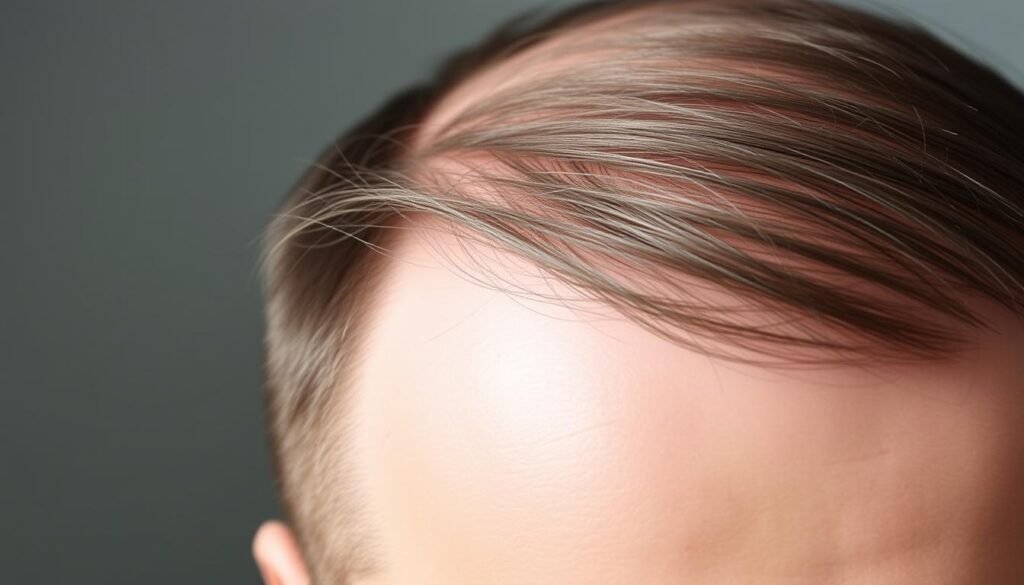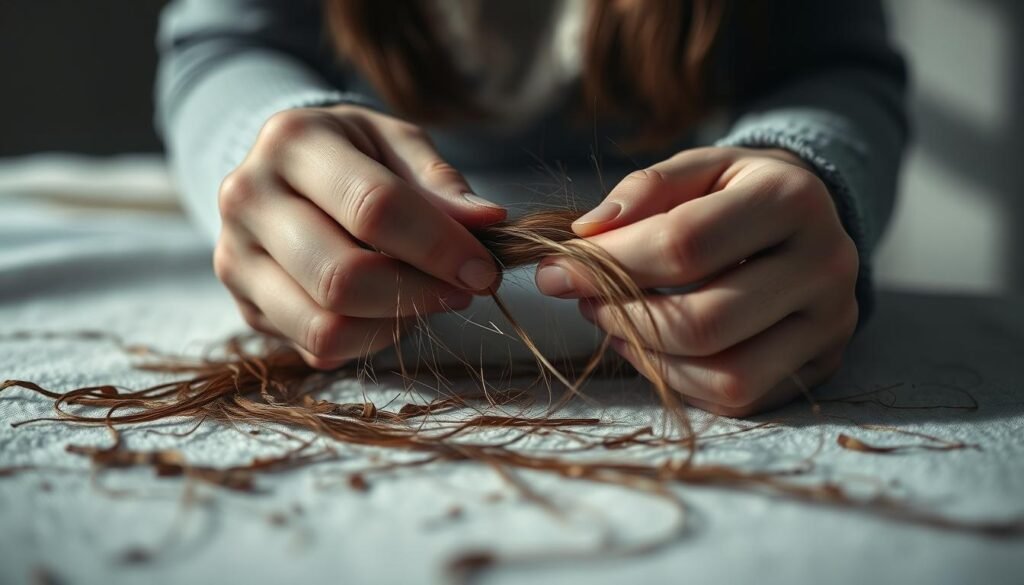Did you know about 50 million men and 30 million women in the U.S. face androgenetic alopecia? This fact shows how common hair loss issues are. It’s vital to know the different alopecia types. From inherited ones like androgenetic alopecia to the rare traction alopecia, hair loss forms vary a lot. Knowing the types helps in finding the right treatment, improving life quality.
Key Takeaways
- Around 80% of men will experience some degree of hair loss by age 70.
- Alopecia includes many hair loss types, each with its own features.
- Knowing each type leads to better treatments.
- Both genetic and environmental elements play a role in hair loss.
- Early intervention can greatly change treatment results.
Understanding Alopecia: An Overview
Alopecia is a complex condition known for causing hair loss. It’s not just one disorder, but a group of types of alopecia. Each type has its own characteristics. Knowing about these conditions helps us understand their causes and how they affect people.
The cycle of the hair follicle is key. Many things can cause hair loss, including your genes and how your immune system works. For instance, androgenetic alopecia shows up differently than alopecia areata or traction alopecia. Knowing the differences between each type is crucial for managing them well.
Hair loss can be tough on a person’s feelings. It can make people feel bad about themselves and change how they interact with others. Research in hair loss is ongoing and could bring new treatments. You can learn more at the Journal of Clinical Investigation.
It’s also important to realize that hair loss often happens because of both genes and the environment. Knowing this can help come up with treatments that are specific to each person. More studies are needed to understand hair loss better. For more information, visit Ageless Glimmer.
| Type of Alopecia | Characteristics | Possible Causes |
|---|---|---|
| Alopecia Areata | Patchy hair loss | Autoimmune response |
| Androgenetic Alopecia | Gradual thinning | Genetic predisposition |
| Traction Alopecia | Hair loss due to tension | Hairstyling practices |
| Telogen Effluvium | Temporary shedding | Stress, hormonal changes |
| Anagen Effluvium | Rapid loss during growth phase | Chemotherapy, toxins |
Exploring Different Forms of Alopecia
Alopecia is a term for different conditions causing hair thinning. Each type has its unique reasons and symptoms. This variety impacts people differently.
Types of alopecia include several key kinds. Alopecia areata is known for quick, patchy hair loss. It can hit anyone at any age, often due to an autoimmune issue. Another type is androgenetic alopecia, also known as pattern baldness. This happens slowly and involves genes and hormones.
Scarring alopecia is less common but very serious. It causes permanent hair loss by injuring the hair follicles. This condition affects people’s feelings about themselves and their confidence.
Below, a table shows the main alopecia types, with details and hair loss patterns:
| Type of Alopecia | Characteristic Features | Age of Onset |
|---|---|---|
| Alopecia Areata | Patchy hair loss, autoimmune disorder | Can occur at any age |
| Androgenetic Alopecia | Gradual thinning, genetic predisposition | Often begins in late teens to early 20s |
| Scarring Alopecia | Permanent hair loss, inflammation of follicles | Varies widely |
Knowing about these alopecia types can help with early spotting and treatment. This might lead to better chances for hair to grow back and help with mental health.
What is Alopecia Areata?
Alopecia areata is a type of hair loss that starts suddenly. It creates patchy areas without hair. This condition is an autoimmune disorder. It can happen to anyone at any age. Knowing about alopecia areata and what causes it is helpful for recognizing it.
Characteristics of Alopecia Areata
People with alopecia areata find round, smooth, bald spots. These spots can show up on the scalp, face, or elsewhere. Oddly enough, hair might grow back without treatment after a while. But, it varies a lot from person to person. Because of its unpredictability, it often causes emotional stress. This makes getting support very important.
Causes and Risk Factors
The reasons behind alopecia areata involve genes and the environment. Having family members with autoimmune diseases might increase your risk. Stress or injuries to the skin can also trigger it. Looking into these factors is important for understanding alopecia. Learn more about the causes of alopecia.
| Characteristic | Description |
|---|---|
| Onset | Sudden and unpredictable |
| Appearance | Round, smooth patches of hair loss |
| Regrowth | Possible, but varies by individual |
| Risk Factors | Family history, other autoimmune disorders |
| Triggers | Stress, skin injuries |
Alopecia Totalis: A Comprehensive Look
Alopecia totalis is a severe type of alopecia areata, leading to total scalp hair loss. It marks the shift from small, patchy hair loss to losing all scalp hair. Those affected struggle with physical, emotional, and mental challenges.
Several factors can trigger alopecia totalis, like genetics and autoimmune reactions. This condition is seen as autoimmune hair loss. The body mistakenly attacks its hair follicles. It’s vital for those impacted to understand these triggers.
For treating alopecia totalis, corticosteroids and immunotherapy are common. They aim to lessen inflammation and change the immune reaction. These methods work towards spurring hair growth and managing symptoms. More insights can be found in an article on alopecia types.
Support groups can greatly help those dealing with alopecia totalis. Connecting with others in similar situations offers significant emotional support. Learning about alopecia totalis can help in better handling and increasing awareness of autoimmune hair loss.
| Aspect | Description |
|---|---|
| Definition | A complete loss of hair on the scalp |
| Type | Autoimmune hair loss |
| Common Triggers | Genetics, environmental factors |
| Typical Treatments | Corticosteroids, immunotherapy |
| Psychological Impact | Emotional distress, potential social withdrawal |
Alopecia Universalis: The Most Extensive Form
Alopecia universalis is the most severe form of hair loss. It leads to the complete loss of body hair. This includes hair on the scalp, eyebrows, and eyelashes. People with this condition face many challenges.
Few people know about this rare condition, which makes diagnosing it hard. Doctors have to rule out other causes of hair loss. They also look for links to autoimmune disorders in a detailed check-up.
Losing all one’s hair affects how they see themselves. For many, hair is key to their look. Losing it can make them feel confused or upset. They have to deal with how others see them and their own feelings about looks.
Getting to know about alopecia universalis can create support for those with it. By being aware and kind, we can ease their emotional pain.
The Impact of Androgenetic Alopecia
Androgenetic alopecia is the most common form of hair loss for both men and women. It leads to a pattern of thinning hair that can have a big emotional impact. It’s caused by genes and hormones.
Understanding Male and Female Pattern Hair Loss
Men with this condition often see their hairline move back and thinning at the crown. This can sometimes lead to complete baldness. Women usually see thinning across their scalp but keep their hairline. This shows why each gender needs a different treatment approach.
Treatment Options for Androgenetic Alopecia
There are several treatments that people use to fight androgenetic alopecia. The most common are:
- Minoxidil: A topical treatment you can buy without a prescription that helps grow hair.
- Finasteride: A medicine that a doctor needs to prescribe. It stops the hormone that causes hair loss.
- Platelet-Rich Plasma (PRP) therapy: An injection that improves how hair follicles work.
Different treatments work better for different people. It’s important to talk to a doctor to find the best one. Knowing about androgenetic alopecia and the treatments can help people take control of their hair loss.

| Treatment | Effectiveness | Common Side Effects |
|---|---|---|
| Minoxidil | Moderate | Itching, dryness |
| Finasteride | High | Decreased libido, erectile dysfunction |
| PRP Therapy | Variable | Minimal discomfort, swelling |
Scarring Alopecia: An Often Overlooked Form
Scarring alopecia, also known as cicatricial alopecia, comes from inflammation and scarring. This condition destroys hair follicles permanently. It can deeply affect a person’s self-esteem and confidence. Knowing about the condition and how to diagnose it properly is key for treatment.
Types of Scarring Alopecia
Scarring alopecia includes several forms, such as:
- Discoid lupus erythematosus: This type mainly hits the scalp, leading to scars and changes in skin color.
- Lichen planopilaris: It is known for itchy scalp patches that can cause hair loss.
- Follicular degeneration syndrome: Mostly found in older people, this rare form causes hair to thin over time.
Diagnosis and Treatment
To diagnose alopecia, a detailed scalp check is needed. A dermatologist might do a biopsy to see if there’s scarring. There are many ways to treat scarring alopecia, depending on its type. Let’s look at some common treatments:
| Treatment Options | Description |
|---|---|
| Topical steroids | These help lessen inflammation and stop more hair loss. |
| Oral medications | Can be corticosteroids or drugs that lower immune response to ease symptoms. |
| Hair transplant | This surgery puts new hair in scarred areas. |
Traction Alopecia: Preventing Hair Loss from Hairstyles
Traction alopecia happens when hairstyles pull too much for too long. Styles like tight braids, ponytails, or hair extensions are common causes. This constant pull makes hair thin out, especially where it’s pulled the most.
To avoid traction alopecia, you can try some things. Here are key ways to prevent it:
- Choose looser hairstyles to ease follicle tension.
- Switch up your hairdos to protect stressed areas.
- Pause tight hairstyles to let your scalp rest.
- Be careful with heavy extensions and accessories.
- Ask a hair care expert for safe style tips.
With these steps, you can cut down your risk. Healthier hair can grow when you take care.

| Hairstyle Type | Risk of Traction Alopecia | Recommended Modifications |
|---|---|---|
| Tight Braids | High | Choose loose twists or box braids. |
| Ponytails | Moderate | Use soft hair ties and vary the position. |
| Hair Extensions | High | Select lightweight options and avoid tight installations. |
| Wigs | Variable | Ensure a proper fit and opt for breathable materials. |
Exploring Telogen Effluvium: A Temporary Condition
Telogen effluvium is a common type of temporary hair loss. It can happen to many people during their lives. It means you lose more hair than usual, because of problems with your hair’s growth cycle. Many things can cause this increase in hair shedding. These triggers lead to noticeable changes in how thick your hair is.
Causes and Triggers
Stress or big changes in your life can often start telogen effluvium. Here are some things that might cause hair loss:
- Illnesses, especially if you have a fever
- Pregnancy and changes in hormones
- Not getting enough iron or protein
- Physical injury or having surgery
- Medications or changes in hormone treatments
Knowing what causes hair loss helps us understand the condition. It also helps us figure out how to deal with it. Most of the time, telogen effluvium goes away on its own a few months after the stressor is gone. This makes it different from other kinds of hair loss that don’t go away as easily. It’s important to be patient, as hair grows back slowly.
If you’re losing hair, talking to a doctor who knows about hair loss is a good idea. They can help you find out if something else is causing your hair loss. Sometimes, eating better or using special hair treatments can help your hair grow back faster. Learn more about telogen effluvium and what you can do about it.
Trichotillomania: Beyond Biological Causes
Trichotillomania is known as a hair-pulling disorder. It’s when someone cannot resist the urge to pull out hair from places like their scalp or eyebrows. This can lead to noticeable hair loss and deeply impact someone’s feelings and mood.
This disorder isn’t just about biology. People might pull their hair as a way to handle stress, anxiety, or past traumas. It can cause them to feel ashamed or alone, changing how they interact with others and see themselves.
Trichotillomania is often found alongside other issues like OCD or anxiety disorder. Knowing how these problems link together helps in finding the right help. Doctors might suggest therapy that helps change the negative thoughts and actions linked to hair pulling.
Being part of a support group can be a big help for those facing trichotillomania. It lets them connect with others who get what they’re going through. This can build a supportive community and offer emotional backing.

| Treatment Approach | Description | Effectiveness |
|---|---|---|
| Cognitive-Behavioral Therapy (CBT) | Targets unhealthy thought patterns and behaviors associated with hair pulling. | High |
| Medication | Antidepressants or anti-anxiety medications may help manage symptoms. | Moderate |
| Support Groups | Facilitates sharing experiences and coping strategies among peers. | High |
Conclusion
This guide looked closely at different types of hair loss, like alopecia areata, androgenetic alopecia, and traction alopecia. It’s key to know the differences to tackle them right. Finding out early can help manage hair loss well, leading to better treatment choices.
Hair loss isn’t just about losing hair. It also affects how people feel inside. Those with alopecia might feel a bunch of emotions. Having support from others and access to mental health help is crucial. Talking more about hair loss can make it less of a taboo.
Getting advice from doctors or joining support groups is a good step. They offer help and understanding for those on this path. This article hopes to encourage readers to face their hair loss head-on. It also stresses the need to keep talking about alopecia and its impact on life.